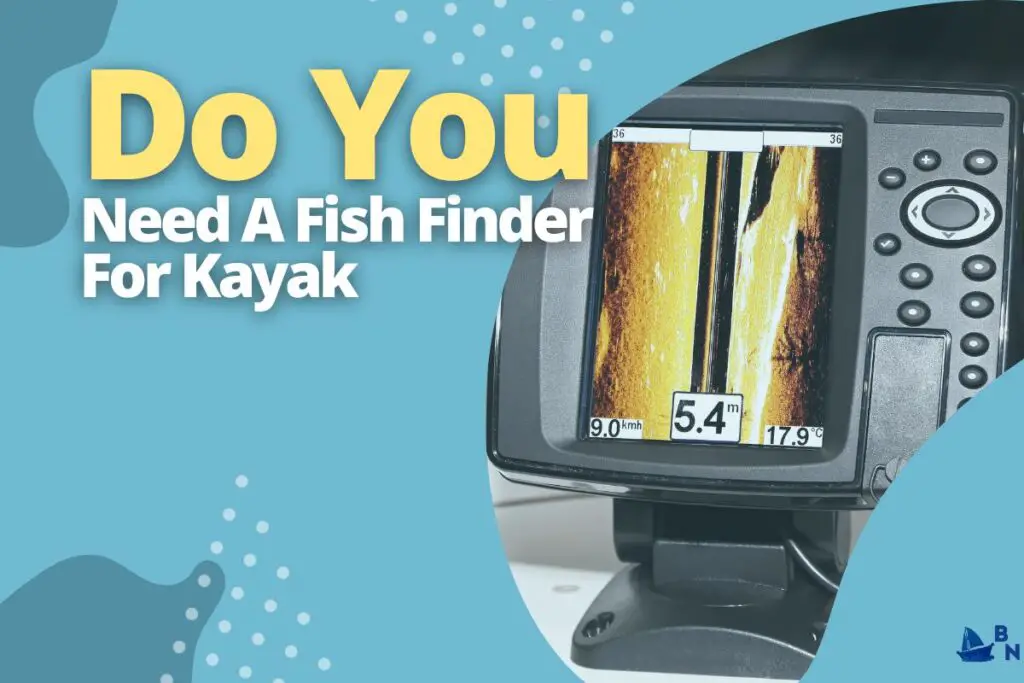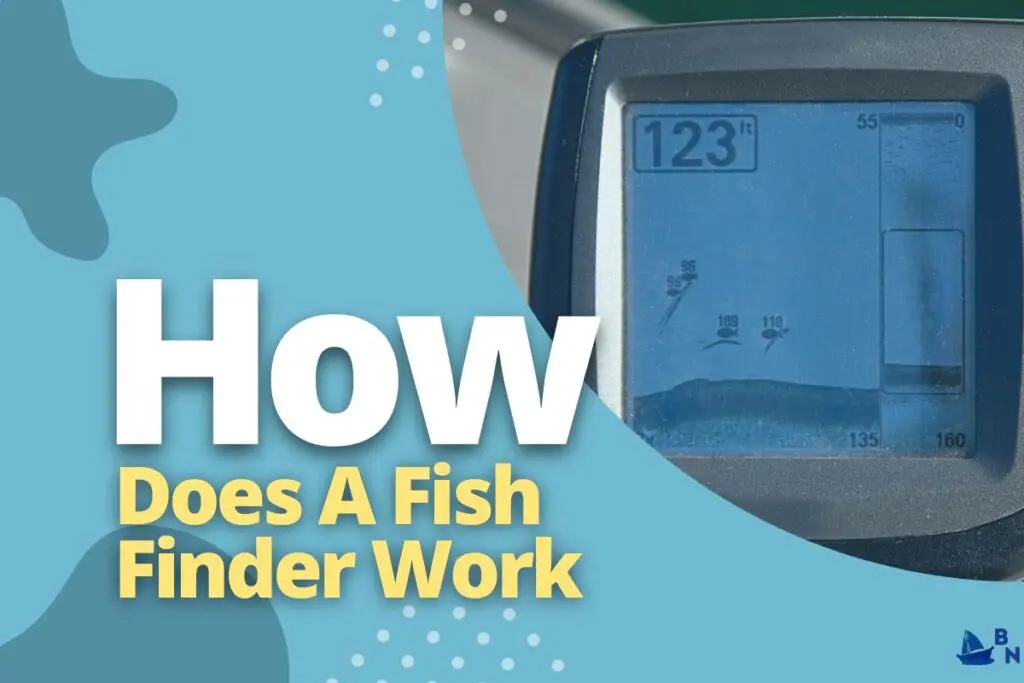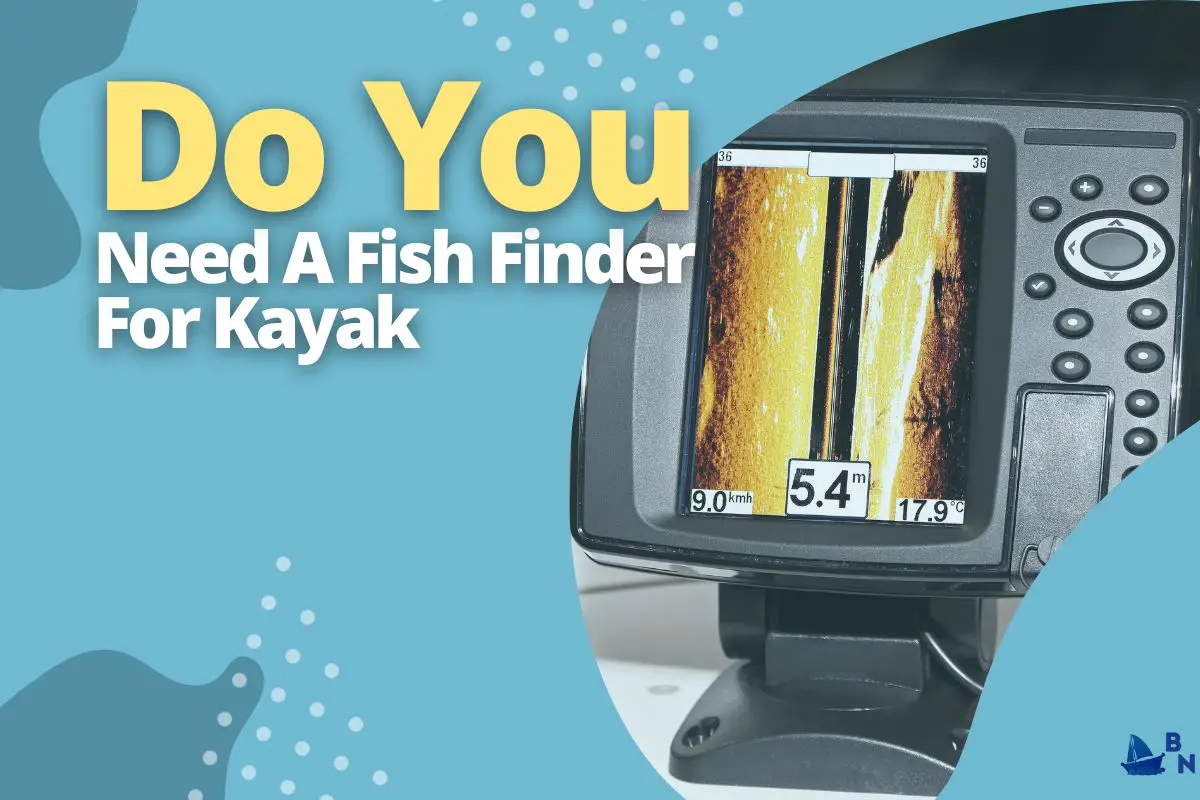Fishing with a kayak is a great way to relax and unwind. But to become a better fisherman, you’ll need to know what fish are.
A fish finder helps you locate fish quickly and easily. Using it is simple. You look at a screen. The screen displays a chart of fish locations. A fish finder works well in open water but is hard to use in a small kayak. You should think about purchasing a fish finder made specifically for kayak fishing.
In this article, I’m going to be very honest with you. I’ll list the benefits and drawbacks of kayak fishing with a fish finder. I’ll also tell you how to use a fish finder and what to look for in a good one.
Key Takeaways
- A fish finder is not a necessary piece of equipment for kayak fishing, but it can be a helpful tool in locating fish.
- Fish finders can be used in shallow and deep water, and sonar to find fish in the water.
- Kayak fish finders are available in portable and permanently mounted models.
- Portable fish finders are less expensive but must be removed from the kayak when not in use.
- Permanently mounted fish finders are more expensive but can be left on the kayak at all times.

Here’s The Answer To Do You Need A Fish Finder For Kayak
No, you don’t need a fish finder for your kayak, but it may help you locate fish more accurately. If you’re an angler who wants to use a kayak for fishing in deeper water, a fish finder can be a valuable accessory.
- It’s essential to conduct research before buying a fish finder because numerous types and brands are available. Some of the most popular brands include Humminbird, Lowrance, and Garmin.
- While kayak fishing, you’ll likely be using a paddle rather than a trolling motor, so you should search for a fish detector that doesn’t consume a lot of electricity.
- The best kayak fish finders will have mapping and down imaging to help you navigate and locate fish in deep water. If you’re new to kayak fishing or on a budget, some less expensive options can still be effective.
- One option is the Deeper Water Portable Fish Finder, an affordable unit using traditional sonar technology.
- A high-end unit will cost extra, but if you’re prepared to do that, the Humminbird Helix 10 SI GPS is one of the best options on the market. This unit has side imaging and CHIRP sonar technology, making locating fish in deep water easier.
Regardless of the sort of fish detector you select, make sure it’s properly mounted on your kayak so that it doesn’t interfere with your paddling or fishing line.
A Kayak Fish Finder Can Be A Valuable Asset For Kayak Fishermen

A fish finder for a kayak can be a valuable asset to any kayak fisherman. As a bonus, you’ll have more time to relax and enjoy your fishing excursion.
In today’s modern world, we must have the latest technology available to us at all times. It helps us save time and makes life easier because we no longer have to waste time searching for things manually.
A fish finder can help you find where most of the fish are located in certain areas so you can spend more time catching them instead of looking for them with traditional methods such as trolling lures or casting poles with baited hooks attached to them.
Focusing on the ocean in front of you will help you avoid distractions like boats driving nearby with loud engines roaring through their propellers.
In short, a good quality GPS device will make sure they stay calm enough so they’ll bite when they see something tasty coming towards them from above.
Some Fish Finders Are Designed Specifically For Use In Kayaks
While some fish finders are designed specifically for kayaks, others are too bulky or simply not powerful enough.
If you want to catch and release fish without worrying about the device weighing down your kayak or draining its battery, then a fish finder specifically designed for a kayak is your best bet.
Some of the features that make these ideal devices include:
- A small screen size (usually 3″–5″)
- Lightweight construction (less than 2 pounds)
- Easily installed on any sit-on-top or sit-inside boat
Kayak Fish Finders Can Be Used To Locate Fish, And Track Their Movements

A fish finder can locate fish, track their movements, and determine water depth. You can use sonar to detect how far away a fish is from your kayak.
Transducers (which function like underwater speakers) are used in some fish finders to transmit sound waves into the water, reflecting off submerged objects and returning to the device. This allows you to see what’s going on beneath you.
Kayak Fish Finders Also Include GPS Capabilities
All kayak fish finders include GPS capabilities. It’s crucial since it lets you remember where you cast off from, so you may return to that area later if you have time.
Additionally, it can help you track fish movements in real time on your screen.
This feature is perfect for anyone who enjoys video games or sports that involve following the movements of objects through space but does not want to venture out into the water.
How Does A Fish Finder Work?

The depth of the water can be determined using a fish finder by sending out a sonar pulse and measuring how long it takes for the pulse to travel and then return.
You can use this information and other data, such as temperature, salinity, etc., to determine if there are any fish in an area.
When using a fish finder, it’s crucial to remember that you can either spook the fish or disturb their environment, reducing your chances of catching them.
What Are The Benefits Of Using A Fish Finder?
When you use a fish finder, you will enjoy many benefits. First and foremost, fish finders help people to track the movements of fish to determine when they are most likely to bite.
This can be done by looking at their GPS location on a map or simply by looking at the movement patterns recorded by the device itself. Fish finders also allow users to determine how deep the water is in any given area; this information can help them predict where specific types of fish might be swimming or hiding.
Additionally, a fish finder allows one to locate areas where certain species are hanging out—for example: if I want to catch trout. Still, they typically stay in shallow water around rocks, and then my best bet would be to look for areas with lots of rocky shorelines.
Finally, using a kayak with an integrated GPS module allows me to see what lies beneath me and know exactly where I am at all times – which is incredibly useful when trying to avoid capsizing.
How To Choose The Right Fish Finder For Your Kayak?
- Screen size: The screen size of your fish finder is essential because it will determine how much information you can see at once. If you are looking for a more compact device, the 7-inch screen might be right for you. This can be mounted in any kayak and is great for beginners and advanced users.
- Screen resolution refers to how sharp the picture looks on your fish finder’s display. You’ll want a high resolution so that even when viewed from close-up, each pixel remains clear; otherwise, you’ll see jagged edges around objects in images which often makes them appear blurry or distorted when viewing from close range with standard resolutions (400×300). However, if this isn’t an issue, then saving money by opting for lower resolutions may prove worthwhile depending on how much detail they display (and whether having it matters).
- Screen type: There are two main types available today – LCD screens that use liquid crystals instead of old-fashioned models while providing crisp images at higher resolutions.
Features To Look For When Choosing A Kayak Fish Finder

You should look for a fish finder with the following features:
- The display size, resolution, and type.
- The screen brightness and resolution.
You’ll be staring at the most as the component of your fish finder; the display is crucial. If you don’t like how it looks, chances are you won’t be happy with what else is on offer either.
A large display is better than a small one because it will give you more information about what’s going on in front of you without taking up too much room on board.
It can also help differentiate nearby objects if they’re similar in size or color to avoid accidents with other boats or wildlife, such as whales or dolphins, which may swim nearby.
Tips For Getting The Most Out Of Your Kayak Fish Finder
- Use the fish finder to locate the structure. Fish will often be found near structures, like rocks and ledges, because there is more cover to hide in.
- Discover where the fish schools are by using a fish finder. Schools of fish are typically found in open areas where it’s easier for predators to pick off individuals who stray away from the group or get isolated from it by strong currents or wave action.
- Use your Fish Finders “fish alarm” feature to find baitfish feeding on smaller organisms like plankton or algae. The alarm will alert you when there is a movement within a certain radius around your kayak—this may indicate food nearby.
How To Install A Fish Finder On Your Kayak?
It is well-known that kayaks are not the most accessible vessels to install a fish finder on. But with the proper equipment and some time, it can be done. If you’re looking to mount a fish finder on your kayak, consider the following advice:
- Choose the right location for the transducer. In a fish finder, the transducer is the component responsible for both transmitting and receiving sonar waves. It needs to be installed where it will have good contact with the water. The hull of the kayak is usually the best spot.
- Drill a hole for the wiring. To power the fish finder, you must run some wiring from the battery to the transducer. This means drilling a hole in your kayak so the wiring can be fed. Make sure you seal up any holes you drill with marine-grade epoxy or silicone so that water cannot get in and damage your kayak!
- Install the battery and wire up the fish finder. Once the wire hole has been bored, you can install your battery and start running the wires through according to your fish finder’s instructions. Make sure everything is properly sealed up and waterproofed before testing it out!
Installing a fish finder on your kayak can seem daunting, but with these tips, it is possible.
Conclusion
I hope that you have learned a lot about fish finders for kayaks and now feel more confident to make the right decision.
Overall, the kayak fish finder is a great tool for anyone who wants to up their fishing game. Although it can be a little expensive, the investment is worthwhile.
With this device, you’ll be able to find fish like never before.
Check out our other articles on fishing equipment and advice. And be sure to follow us on social media for updates on new products and deals.

